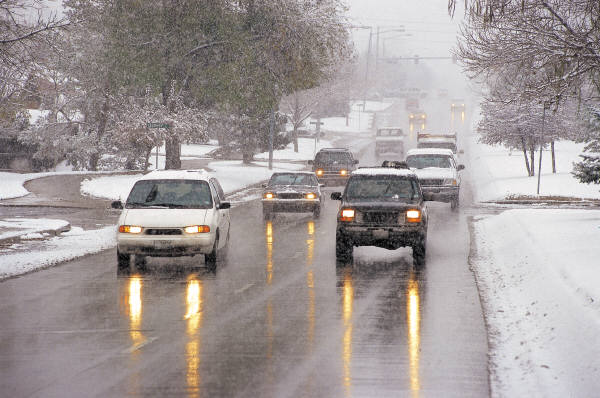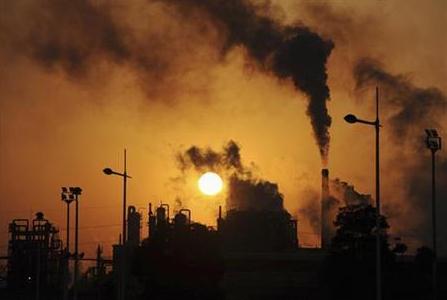
My wife once told me that women suffer from a kind of chronic, collective amnesia. "If we couldn't train our brains to forget the pain of childbirth nobody in their right mind would consider having a second or third child" she said.
So it goes with the icy, snow-encrusted near-death experience we politely refer to as winter. Observations: 32F feels so much worse in October than March. It takes a couple of snow events before we relearn how to navigate on snow and ice; more "controlled surfing" than driving.
No problems today or Thursday; 50s with fading sun. A cold front changes rain over to wet, sloppy snow Friday, and a slushy coating is possible late Friday into Saturday morning - possibly enough snow to whiten lawns. Temperatures dip below 32F late Friday night and roads could get slushed up. Whatever falls should melt by Saturday afternoon. Consider it a nudge, a tap on the shoulder from Old Man Winter.
Slush may come about 6 days earlier than normal; earlier than it has the last 4 autumns.
Good news: Halloween looks dry with temperatures in the 40s. Yes, it could be much worse.
Tuesday Satellite. This is one of the more compelling images I've seen; Suomi NPP VIIRS True Color, courtesy of UW-Madison CIMSS. Outstanding.
Snowfall Potential: NAM. NOAA's 12km NAM suggests the best chance of a few inches of snow over far northern and western Minnesota; little or no accumulation for the Twin Cities - but a few inches for Fargo, Detroit Lakes and Bemidji. Map: Tropicaltidbits.com.
Snowfall Potential: European Model. Tuesday's 12z ECMWF shows the best chance of a few inches of slush over far southwestern and southeastern Minnesota. I just love it when the models agree. Ugh.
First Flakes. The Twin Cities office of the National Weather Service helpfully reminds all of us that the first coating (1/10th of an inch) of snow falls, on average, on November 2.


Extreme Weather, Climate Change Costing Taxpayers Billions. Here's an excerpt of a summary of a new government (GAO) report highlighted at NBC News: "Climate change is costing taxpayers billions of dollars in disaster relief and the tab will only increase as extreme weather events become more common, according to a new government study. The federal government has spent an estimated $350 billion over the past decade responding to extreme weather and fire events, which are exacerbated by climate change, according to the Government Accountability Office (GAO) report. It comes as Congress moves to approve billions of dollars in extra funding for hurricane relief. "Climate change impacts are already costing the federal government money, and these costs will likely increase over time as the climate continues to change," the report found..."
2017 Could Tie Record for Billion-Dollar Disasters in a Year. Here's Why. A story at USA TODAY caught my eye: "And
the year's not over yet. This year's devastating hurricane season is
largely to blame. Hurricane Harvey will likely end up topping all of
this year's disasters with an estimated price tag of $190 billion. The
official death toll, now at 48, in Puerto Rico from Hurricane Maria
could rise into the hundreds, according to a report Wednesday from Vox.
Hurricane Irma ravaged the Caribbean island of Dominica as Category 5
monster, destroying most of the island's structures and leaving the
infrastructure in ruins. It then took aim on the U.S. Virgin Islands and
eventually the U.S. mainland. It was also was a Category 5 storm for
longer than all other Atlantic hurricanes on record except Ivan in 2004..."
NYC Looking at a Flooded Future: From
Climate Nexus Hot News: "Catastrophic flooding levels considered
once-in-500-year events when New York City was founded could hit the
city once every five years within a few decades, according to new
research. A study published Monday
in the journal Proceedings of the National Academy of Science finds
that while a warmer climate may cause more storms to swerve away from
the city in the future, the storms that do hit New York will bring
devastating floods due to rising sea levels. Researchers say that
7.5-foot flooding in New York, a rarity before 1800, now occurs once
every 25 years, and could rise to once every five years by 2030. The
study also projects that a once-in-500-year flood event by 2100 could
possibly flood parts of the city by up to 17 feet, dependent on the
state of the Antarctic ice shelf. Superstorm Sandy, which hit the city
five years ago this week, brought 9.2-foot floods that inundated
thousands of buildings, knocked out power and decimated the subway
system." (AP, Washington Post $, The Atlantic, InsideClimate News)
Photo credit: "Water from New York Harbor surrounds the southern tip of New York’s Manhattan borough on Tuesday, Oct. 17, 2017, seen from aboard a Staten Island Ferry. Superstorm Sandy roared ashore five years ago, Monday, Oct. 29, 2012, devastating the coastlines of New Jersey, New York and parts of Connecticut and becoming one of the costliest storms in U.S. history." (Seth Wenig/Associated Press).
New York's Fate is Closely Tied to Antarctic Ice, Climate Scientists Warn. Chris Mooney explains at The Washington Post: "New York City’s ability to withstand hurricanes could hinge on the state of the Antarctic ice sheet some 8,000 miles away, according to a study published Monday. Using computer projections to simulate thousands of storms in potential future climates, researchers found that storms would be more likely to swerve away from the city. The trouble is the storms that do approach will, on average, be more powerful. And all storms that hit New York, regardless of their power, will start at a higher baseline, as they’ll be traveling on seas that have risen due to climate change. The result is that the risk of a storm similar to Hurricane Sandy, albeit with a slightly smaller storm surge, has gone from a one-in-500-years event in 1800 to a one-in-25-years event today. By the period between 2030 and 2045, such storms could become a one-in-five-years event, according to the projections..."
File photo: "Stormy seas crash into a pier along the northeast U.S. coast." (Proceedings of the National Academy of Sciences)
How Cities Are Defending Themselves from Sea Level Rise. AP and The Washington Post have the story: "Superstorm Sandy and a series of lesser coastal storms since that 2012 disaster compelled some coastal communities to defend themselves by elevating homes and critical infrastructure, building sand dunes, widening beaches and erecting or raising sea walls. But as sea levels continue to rise around the world, that’s not an option in large cities, where skyscrapers can’t be elevated and subway and train tunnels act as turbocharged flumes when millions of gallons of stormwater rush through them. The answer, some cities have decided, is a mixture of hard and soft barriers; green infrastructure to capture rain and absorb storm water; temporary storage space for runoff; and drastically increased pumping measures..."
File photo: Matt Merrifield, AP.
Forest Fires Stoke Record Loss in World Tree Cover: Monitor. Reuters has the details: "Forest
fires in Brazil and Indonesia contributed to a record loss in global
tree cover in 2016, equivalent to the size of New Zealand, that could
accelerate deforestation blamed for climate change, an independent
forest monitoring network said on Monday. Man-made global warming
increased the risks of wildfires by adding to extreme heat and droughts
in some regions, according to Global Forest Watch (GFW). This year,
California and Portugal have been among places suffering deadly blazes.
The combination of forest fires with land use change and climate change
could speed destruction in areas like the Amazon and contribute to
emissions of carbon dioxide, one of the gases that contribute to global
warming, the report said..."
File photo credit: "Police
and a fire fighter from a local forestry company try to extinguish a
forest fire in the village in Rokan Hulu regency, Riau province,
Sumatra, Indonesia August 28, 2016 in this photo taken by Antara Foto.
Picture taken August 28, 2016." Antara Foto/Rony Muharrman/via REUTERS
The Only California County That Sent a Warning to Residents' Cellphones Has No Reported Fatalities. Coincidence? Here's a clip from The Washington Post: "...Five
years after it was launched by the Federal Emergency Management Agency,
the use of the nation’s alert system remains uneven. And despite a
campaign by FEMA to encourage local governments to participate, most
U.S. counties could not order an alert today if they faced an emergency.
More than 65 percent of the nation’s 3,500 counties do not have
agreements in place with FEMA to send alerts through the Wireless
Emergency Alert system, as it is known, the agency said. The alerts are
sent to all phones in the targeted area, often accompanied by a
vibration and a unique sound that FEMA says is “designed to get your
attention.” The majority of alerts sent over the system since 2012 —
more than 25,000 — have been related to flash floods, tornadoes and
other weather events, FEMA records show..."
Image credit: "Sue Fellbaum returns to her home of 28 years that has been burned to the ground by the wildfires in Santa Rosa, Calif." (Whitney Shefte, Elyse Samuels/The Washington Post).* More on weather alerts issued during the recent California wildfires from HuffPost.
Is Weather Control a Dream or Nightmare? Science News for Students separates out the science from the conspiracy theories: "...There’s a lot of natural variability,” explains Jeffrey French. He’s an atmospheric scientist at the University of Wyoming in Laramie. In time, money for cloud-seeding research dwindled. More effort was put into improving weather prediction. Weather modification did not, however, disappear. More than 50 nations now have cloud-seeding programs, according to the World Meteorological Organization. China, for instance, set off hundreds of rockets to seed clouds in 2008. Its goal was to ensure clear skies for the opening ceremonies of the summer Olympics in Beijing. There also are dozens of private weather-modification companies. And many other companies pay for cloud seeding. What they achieve, today, is much more subtle than the grand visions that had once been proposed..."
Image credit: "Weather control is the stuff of science fiction, but scientists have made it at least a little bit real. Whether people should be controlling their weather, though, is another matter." Nastco/iStockphoto.

* Access to the paper referenced above is available at The Lancet.
Subsidizing Coal is Far From Conservative. Here's an excerpt of an Op-Ed at Bloomberg: "...In addition, let's recognize that Perry is pushing for coal to be rewarded for one positive attribute, "resilience," even as the administration downplays a glaring negative one, carbon emissions. Maximilian Auffhammer, a professor at the University of California at Berkeley, captured this inconsistency in a recent blog post:
Subsidizing coal for its reliability attributes is like subsidizing bacon for its nutritional content.Ignoring the problem of climate change, or setting irrational thresholds for action, is to just roll the dice. Jerry Taylor, founder of the libertarian think tank Niskanen Center, put it this way in a detailed paper stating the case for a carbon tax, published in 2015:
Risks from climate change are real and a policy of ignoring those risks and hoping for the best is inconsistent with risk management practices conservatives embrace in other, non-climate contexts..."
Solar Costs Set to Fall Further: From Climate Nexus Hot News: The already-plummeting costs of installing solar power could fall an additional 60 percent over the next decade, the head of the International Renewable Energy Association said Monday. IRENA director general Adnan Amin told Reuters that the organization expects an additional 80 to 90 GW of solar capacity will be added worldwide each year for the next five to six years, and that improvements in technology, including batteries, will help drive down costs. Earlier this month, a new solar project in Saudi Arabia set a record for the lowest bid prices ever recorded for solar energy at 1.79 cents/kWh. A report from the International Energy Organization earlier this month hailed a "new era" for solar, naming it the fastest-growing source of new energy in 2016. (Irena: Reuters, PV Magazine. Saudi Arabia: Bloomberg. IEA: Reuters, CNBC, The Guardian, Bloomberg, Mashable. Commentary: ThinkProgress, Joe Romm column)

Over 40% of Tech Workers Worried About Losing Their Jobs to Ageism. Bizjournals.com has the details: "More
than 40 percent of tech workers polled are worried they will lose their
jobs because of ageism, a new study from job listing site Indeed, with almost 20 percent saying they worry “all the time” about becoming too old for their jobs. Indeed
polled 1,000 tech workers in September 2017 for its study, which found
that 46 percent of the tech sector is comprised of millennials, with a
much smaller minority of 26 percent made up of baby boomers and Gen
Xers. The average tech worker polled had been in tech for 15 years and 9
months, with 36 percent saying the average age at their company is
between 31 to 35..."
A Bike-Sharing War Is Coming to the USA. A story at Recode talks about what's coming: "Forget
the ride-sharing wars. Transportation has a new battleground:
Bike-sharing. After seeing great success in places like China and
Europe, dockless or free-floating bike-sharing has started to expand
aggressively into the U.S. — but with that comes staunch opposition from
incumbent players and, in some cases, the very cities they’re trying to
court. For the uninitiated, dockless bike-sharing works a lot like
today’s bike-sharing systems, except you can, in
theory, park the bikes anywhere, locking and unlocking them by scanning a
QR code with an app. That differs from current bike-sharing programs in
places like New York and San Francisco, where bikes are docked to fixed
locations. Dockless bikes are also GPS enabled, allowing companies to
easily track and move them around to places of high demand..."

File image: NASA.
Image credit: "The Iditarod Trail Committee identified four-time champion Dallas Seavey as the musher whose dogs tested positive for a banned substance in this year’s race." (Amber Ferguson/The Washington Post)
51 F. maximum temperature yesterday in the Twin Cities.
54 F. average high on October 24.
56 F. high on October 24, 2016.
October 25, 1887: Albert Lea sets a record low of -6 degrees F.
October 25, 1830: A 'heat wave' hits Ft. Snelling. The high temperature reached 80.
TODAY: Partly sunny, less wind. Winds: NW 8-13. High: 57
WEDNESDAY NIGHT: Partly cloudy. Low: 44
THURSDAY: Clouds and winds increase. Winds: SW 10-20. High: 56
FRIDAY: Rain changes to wet snow. Winds: N 15-25. Wake-up: 40. High: 43 (falling)
SATURDAY: Slushy start? Flurries taper off. Winds: N 10-20. Wake-up: 30. High: 39
SUNDAY: Partly sunny, feels like fall again. Winds: NW 8-13. Wake-up: 28. High: 45
MONDAY: Mostly cloudy, colder breeze kicks in. Winds: NW 10-15. Wake-up: 29. High: 43
HALLOWEEN: Cool sun. Dry for trick or treating. Winds: NW 8-13. Wake-up: 30. High: 44
Climate Stories...
Photo credit: "Joseph Leader, the vice president of the New York MTA, inspects a flooded escalator down to a subway platform in the days after Hurricane Sandy." Mike Segar / Reuters.
Photo credit: "Florida Rep. Carlos Curbelo has joined 20 Republican colleagues on a resolution that calls conservation a “conservative principle.” (Bill Clark/Roll Call File Photo).
Sea Level Rise Could Flood 1.9 Million U.S. Homes by 2100. Yale E360 reports: "An estimated 1.9 million U.S. homes could be flooded by 2100 if seas rise 6 feet in response to climate change, according to a new analysis by the real estate company Zillow. The affected properties are valued at $916 billion dollars and represent 1.8 percent of the country’s housing stock. The report, published last week, finds that without climate resiliency measures such as sea walls, the majority of flooded homes will be moderate- or lower-priced properties. High-end real estate accounts for 39 percent of at-risk houses. “While the damage caused by recent hurricanes is a devastating reminder of how quickly the weather can undo people’s lives and destroy their homes, the potential for damage from a slower-moving phenomenon could be even more destructive,” the report says..."
Photo credit: "Lindsay Mouw, 23, of Sioux Center has taken her message of acting against global climate change to fellow church members and the conservative northwest Iowa community." Mike Kilen.
Global Warming Could Make This Lurking Climate Threat Even Worse. Forbes explains: "...Like carbon dioxide, nitrous oxide (yes, the same stuff as laughing gas) traps heat in Earth’s atmosphere. Although it’s thought to account for only about 6% of the greenhouse effect today, it is about 300 times worse for the climate than CO2. One major source is runoff from farms and fields. Bacteria breaking down nitrogen compounds from manure and synthetic fertilizers generate nitrous oxide as a waste product. Climate scientists and policy makers have tried to include nitrous oxide in their models of climate change. But until now we haven’t had a good idea about whether nitrous oxide emissions will get worse or better as global temperatures increase..."
File photo: iStock.
Very valuable information, I was looking for something like that and found it here. Keep up writing.
ReplyDeleteCheck this out
My Blog